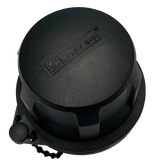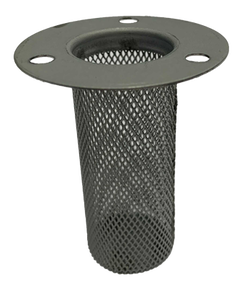|
|
Stauff filler breathers are tools used in hydraulic reservoir tanks to give the reservoir breathing allowance at the same time, securing the tanks from contaminants. They are mostly used to secure reservoirs placed in harsh environments from any dirt or contaminant that could block the pathway of fluid or cause other damages. They are available in different models which are SMBT, SMBB, and SMBP. These models also have various series types. The Stauff filler breathers have a bayonet version with a three-hole system and a cap diameter measuring 47mm. The maximum flow rate for Stauff Filler Breathers is 0.45 m³/min or 15.89 cfm. |
Material Specification |
|
Design Standard |
|
Temperature Range |
|
1. What are Stauff Filler Breathers?
|
Stauff filler breathers are made to serve as filler ports for hydraulic reservoirs and tanks. They give a breathing allowance for the tanks whilst shielding against contaminants in harsh environments. These filler breathers can be used to sieve the oil into the tank and are connected using the threaded end type.
The threaded version has two forms, the male BSP thread made following the ISO 228 standards and the male NPT threaded made following the ANSI B1.20.1 standards. Stauff filler breathers are designed to accommodate 0.45 m³/min or 15.89 cfm. |
2. What is the Stauff Filler made of?
The Stauff filler breathers are made of components from different materials. The breather cap is made from steel, which has a chrome plating or epoxy coating. Steel is an iron alloy that contains a percentage of carbon. This carbon element helps the material gain more strength and increases its fracture resistance. Also, it can contain a percentage of chromium which increases the level of corrosion resistance. Steel is a common material often used in building and ship construction, electrical appliances, automobiles, machines, and lots more.
The table below shows the chemical composition of steel:
The table below shows the chemical composition of steel:
|
Chrome plating also referred to as chromium plating is a technique of creating a metal coating of chromium into a metal material. In this case, the steel is electroplated with chromium. This is done to increase the corrosion resistance of the product because chromium is an anti-corrosive element.
For epoxy coating, a polymerization of two elements, epoxy resin, and hardener to increase the material's durability and strength. The bayonet flange of the filler breathers is also made from chrome-plated steel. The basket of the filler breather is made from zinc-plated steel. During the process of zinc-plating, a thin coat of zinc is applied to the steel to guide the tool against rusting. The sealing is made of cork. Cork is a material composed of a hydrophobic substance called Suberin. The material is widely known due to its elastic, and fire retardant features. Cork is a good material for gasket or sealant. |
3. What are the types of Stauff Filler Breathers?
The stauff filler breathers are available in various sizes which are explained below:
- Metal filler breather (Lockable SMBL series): this is a type that can be applied in tank filling and for reservoir breathers. It is available in thread style, clamp, and push-on styles. It operates on a temperature range between -22⁰F (-30⁰C) to 212⁰F (100⁰C). Metal filler breather is designed with two lockable keys. The filler breather body is made of Die case, which is either zinc plated or blue chromated. The baskets are zinc-plated steel or polypropylene and it has a Buna-N seal, however, other seal types can be available on request.
- Plastic Filler Breather (SPB series): the plastic filler breathers are also used for reservoir filling and tank filling. It is available for connection with the screw-in type or bayonet connection. It is made with non-corrosive materials which gives it a long operating period. The temperature level is between -40⁰C (-40⁰F) to 120⁰C (248⁰F). It comes with the Buna-N seal, however, a request can be made for other types. The basket is made from polypropylene (PP) and the others from glass fiber reinforced polyamide (PA). For other configuration types. Requests can be made and it will be available.
- Plastic Filler Breather (SES Series): the plastic filler breather (SES Series) has a change duty asides from the first two explained above. These are used for ventilation and tank filling. The plastic breather (SES Series) is designed with the NBR seals. The plastic and breather cap is made from polyamide (PA), and the nut and socket from steel (1.0718). However, upon request, polyamide nuts can be available. The Dipstick is made of Steel (9SMnPb28) and the air filter from Sintered Bronze.
- Screw-in and Bayonet Filler Breathers (SPBN Series): the screw-in SPBN Series is used in industries for ventilation and reservoir t=filling. They are designed either as screw-in fillers or bayonet filler breathers. It is also very high in corrosion resistance and operates on a temperature range between -40⁰C to +120⁰C (-40⁰F to +248⁰F). The filler breather comes with an NBR seal, however, other seal types are available on request. It is made from Glass-fiber reinforced polyamide (PA).
|
Further, the plastic dipsticks are designed with integrated anti-splash feature and it gets pressurized at 0.20 bar or 3 PSI, 0.35 bar or 5 PSI, and 0.70 bar or 10 PSI. for the connection, the thread style BSP and NPT are available. For other special configurations, requests can be made for availability.
Giant Air Breathers (Style SGB90C and SGB120C): the giant air breathers come with a 3 Micron Absolute Synthetic Media Filtration tool. They are suitable for use in industries operating with petroleum and mineral-based fluids. The airflow rate for the SGB-90C is 0.51m³/min (18 CFM), while the SGB-120C has 1.56m³/min (55 CFM). Other connection options for the SGB-90C are 3/4” NPT Connector and 1 1/4” NPT connector for SGB-120C. |
The table below shows the specifications for the SGB90-10P:
Part Number |
Absolute Micron Rating |
Air Flow Capacity Cfm (m³/min) |
Air Displacement Gpm (lpm) |
Filtration Area Sq in Sq cm |
SGB90-10P |
10 (Nominal) |
40 (1.13) |
300 (1.135) |
109 (700) |
4. What are Dipsticks?
|
Dipsticks are used with Stauff Air Breathers. These instruments are used to measure the level of fluid in a hydraulic tank or reservoir and it can be used as a testing tool. Dipsticks are widely used in various industries for different purposes. Dipsticks are made from Polyamide material and are available in 200mm / 7.87 inches or 300mm / 11.81 inches.
Regardless of these standard lengths, dipsticks can be cut into a specific length based on the requirement of the application. Further, dipsticks are designed with two adjustable level indicators in red and green color for easy identification. When working with fluids, ensuring it is free from contaminants is a topmost priority. The baskets in the filler breathers serve as a sieving agent when filling the tanks with oil, thus removing all particles from the liquid before it is stored. For the Stauff filler breathers, the basket is made of various materials based on the series bought. |
stauff filler breathers catalogue









